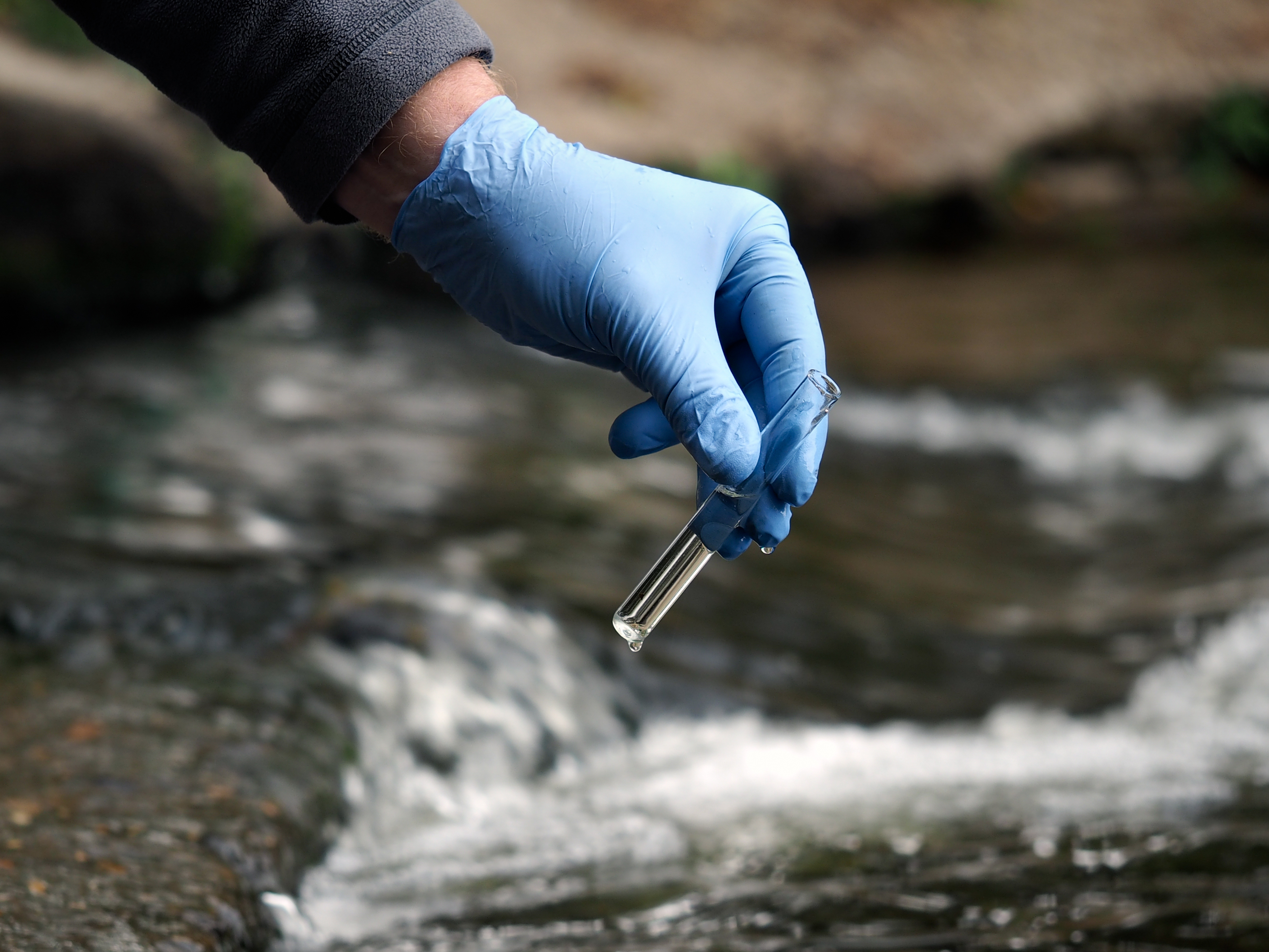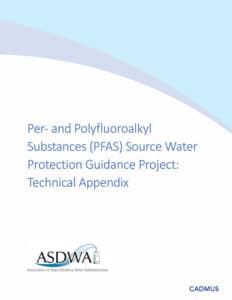

PFAS are a class of thousands of different chemicals that have been manufactured and used in a variety of commercial products since the 1940s – from everyday household items to food packaging – due to its heat, moisture, and stain resistance and non-stick qualities. PFOA and PFOS have been the most extensively produced and studied of these chemicals, followed by PFHxS and PFNA. These chemicals do not break down in the environment or human body, and can accumulate over time. There is evidence that PFAS exposure can lead to adverse health effects.
ASDWA facilitates engagement and develops resources to support state drinking water program PFAS regulations, policies, and actions for drinking water utilities across the nation. These efforts help protect public health by identifying and mitigating PFAS contamination at customer taps and in their drinking water sources.
ASDWA promotes using a holistic lifecycle approach that considers PFAS impacts across all environmental media and from manufacturing through disposal of products containing PFAS. Protecting drinking water sources is much more effective and less expensive than having states, drinking water utilities, and their customers pay to remove PFAS once drinking water has become contaminated.
PFAS Background: The understanding of potential drinking water impacts from PFAS has significantly increased over the past decade. This class of chemicals started to get publicity in 2001 & 2002 due to water contamination from the Washington Works Plant located outside of Parkersburg, West Virginia, on the West Virginia/Ohio border. The class-action lawsuit against DuPont due to water contamination at Little Hocking Water District and Lubeck Public Service District generated additional publicity. In 2006, DuPont and other manufacturers such as 3M, agreed to principally phase out the production of PFOA and PFOS.
The Number of PFAS Being Manufactured Continues to Grow: There are thousands of PFAS compounds being used in commerce. Since the phase-out of PFOA and PFOS, companies have shifted to “short-chain” PFAS. Except for the 29 PFAS on UCMR5, current analytical methods are unable to detect these other short-chain compounds. The increasing number of PFAS of concern is creating a host of data collection and analysis issues, as regulators and researchers are struggling to get enough robust health effects, analytical methods, and treatment data to enable decision-making.
ASDWA Comments on EPA’s Preliminary Effluent Guidelines Program Plan 16 – January 2025: These comments broadly support Plan 16 and particularly the actions aimed at assessing and addressing contaminants in NPDES permits that impact downstream drinking water sources such as PFAS and nutrients. The comments also emphasize that EPA must engage and coordinate directly with states on Plan 16 actions.
ASDWA Joint Letter of Comment with ACWA, ECOS, and ASTSWMO on EPA Changes to EPCRA PFAS Reporting Requirements and Supplier Notifications for Chemicals of Special Concern – February 2023: Our joint comments support EPA’s action to add PFAS to the list of Chemicals of Special Concern (CSC) with specific requirements for reporting under EPCRA; remove the de minimis exemption for Supplier Notification Requirements for PFAS and all chemicals on the list of CSC; and request that EPA pursue a supplemental rulemaking to ensure that all PFAS added to the TRI are also added to the CSC List.
ASDWA Joint Letter of Comment with ACWA, ECOS, and ASTSWMO on EPA’s ANPRM for PFAS Effluent Limitations Guidelines – May 17, 2021: Our joint comments highlight the need to prevent PFAS pollution and difficulty in generating PFAS data due to the lack of analytical methods for monitoring surface waters.
ASDWA Letter of Comment on EPA Interim PFAS Destruction and Disposal Guidance – February 2021: This letter highlights concerns for state drinking water programs and water utilities and provides recommendations for EPA to undertake a holistic lifecycle approach to assess and address PFAS destruction and disposal impacts for drinking water and to protect public health.
ASDWA PFAS MCLs White Paper – November 2021: This White Paper entitled, “Lessons Learned from States and Challenges Ahead in Setting State-Level Per- and Polyfluoroalkyl Substances (PFAS) Standards,” provides an overview of current state PFAS efforts and seven topic sections on the key components of the regulatory setting process for states that are developing or considering developing PFAS drinking water Maximum Contaminant Level (MCL) regulatory standards or guidelines, or want to take other actions to assess and address PFAS. View the November 29, 2021 webinar recording and slides here.
On April 26, 2024, EPA released the Final NPDWR for PFOA and PFOS, and four additional PFAS. EPA set a Maximum Contaminant Level (MCL) of 4 parts per trillion (ppt) for PFOA and PFOS, and 10 ppt for PFHxS, PFNA, and HFPO-DA (GenX). In addition to these five MCLs, EPA included a Hazard Index for mixtures of two or more of four PFAS including PFHxS, PFNA, GenX, and PFBS. The Hazard Index is a tool used to evaluate potential health risks from exposure to chemical mixtures. This approach has been used in other EPA programs, such as the Comprehensive Environmental Response, Compensation, and Liability Act (CERCLA), but this is the first time it has been used for a drinking water standard. Additionally, EPA has finalized Maximum Contaminant Level Goals (MCLGs) for each of the six PFAS. The MCLs and MCLGs are as follows.
| Compound Name | Final MCLG | Final MCL | |
| PFOA | Perfluorooctanoic acid | 0 ppt | 4.0 ppt |
| PFOS | Perfluorooctanesulfonic acid | 0 ppt | 4.0 ppt |
| GenX | Hexafluoropropylene oxide dimer acid | 10 ppt | 10 ppt |
| PFHxS | Perfluorohexanesulfonic acid | 10 ppt | 10 ppt |
| PFNA | Perfluorononanoic acid | 10 ppt | 10 ppt |
| Mixture | Two or more of PFHxS, PFNA, GenX, and PFBS | HI* = 1 | HI* = 1 |
*Hazard Index (HI) is unitless
For the Hazard Index, the rule uses a ratio for two or more of the four PFAS to calculate a compliance value based on detected levels of PFAS. If the combination of ratios is at or above 1 (unitless), then water systems are expected to reduce the levels of these PFAS.
EPA PFAS NPDWR Implementation Guidance Website
EPA PFAS Drinking Water Actions Timeline
HAs Versus Regulatory Standards
Use of HAs as guidance, versus a SDWA regulation with an established MCL created challenges for state drinking water programs and public water systems. Because they are not legally enforceableand and do not consider feasibility, costs, or benefits of reducing contaminant levels like a federal NPDWR. The HAs also do not clarify necessary actions for water systems to address the compounds, and how to communicate their actions and the associated health risks to the public.
In the case of PFOA and PFOS: The interim health advisories were intended to be in place during the time interval between initial understanding of health effects and publication of the final health advisory or maximum contaminant level goal (MCLG) and NPDWR.
EPA’s Health Advisories (HAs) for PFAS: EPA’s PFAS HAs for drinking water began with the first and highest levels for PFOA and PFOS in 2009. These levels were lowered in 2016 and again in 2022 based on new data and health studies. These HAs informed the development of the PFAS NPDWR.
EPA PFAS Health Advisories
| Compound Name | 2009 EPA HAs | 2016 Revised HAs | 2022 EPA HAs | |
| PFOA | Perfluorooctanoic acid | 400 ppt | 70 ppt (individual and combined sum with PFOS) | .004 ppt* |
| PFOS | Perfluorooctanesulfonic acid | 200 ppt | 70 ppt (individual and combined sum with PFOA) | .02 ppt* |
| GenX | Hexafluoropropylene oxide dimer acid | NA | NA | 10 ppt |
| PFBS | Perfluorobutane sulfonic acid | NA | NA | 2000 ppt |
*EPA interim HA levels.
ASDWA PFAS – Source Water Protection Guide and Toolkit

ASDWA developed this guide and toolkit with support from a Project Advisory Council (PAC) with representatives from nine states (Colorado, Kansas, Minnesota, New Hampshire, North Carolina, Pennsylvania, Vermont, Virginia, and Wisconsin), and the Cadmus Group. The purpose of the guide is to demonstrate and share effective strategies for addressing PFAS contamination risk in source waters that will help inform policy decisions, assist state drinking water programs in protecting public health, and encourage collaboration and communication among states and water utilities.
The ASDWA PFAS SWP – Decision Support Tool is downloadable in Excel and provides examples of state actions to address PFAS contamination. It includes an update form for states and other organizations to submit updates or new entries for the Tool.
The factsheet for Communicating with Industry on PFAS Contamination includes best practices and questions with fillable fields to support state planning efforts.
The Technical Appendix includes an overview of PFAS, chemicals of concern, PFAS in the U.S., and state PFAS profiles.
The Mapping Guide aids identifying and mapping source waters that are vulnerable to PFAS contamination.
Before the final NPDWR was published, some states developed their own PFAS standards and guidelines. These states acted to protect the public health from the impacts of PFAS contaminated drinking water in the absence of a federal rule. The table below shows the states that proposed or established PFAS standards or guidelines before the Final NPDWR was published. These numbers demonstrate the variation in health risk goals and risk reductions among states in the absence of federal standards and are creating public confusion about what levels of PFAS are safe in drinking water.
State Actions to Address PFAS in Drinking Water
| State | Drinking Water Action | Compound | Level (ppt) |
| California |
PFOA PFOS PFBS PFOA PFOS PFBS |
10 40 5000 5.1 6.5 500 |
|
| Connecticut | Action Level | Sum of PFOA, PFOS, PFNA, PFHxS, PFHpA | 70 |
| Illinois | Health Advisory Levels 7/27/21 |
PFOA PFOS PFNA PFHxS PFBS PFHxA |
2 14 21 140 2100 560,000 |
| Massachusetts | Adopted Regulation 9/16/20 | Sum of PFOA, PFOS, PFNA, PFHxS, PFHpA, PFDA | 20 |
| Michigan | Adopted Regulation 8/3/20 |
PFOA PFOS PFNA PFHxS PFBS PFHxA GenX |
8 16 6 51 420 400,000 370 |
| Minnesota |
Health Based Guidance for Water Surrogate of PFOS HBV |
PFOA PFOS PFHxS |
35 15 47 |
| New Hampshire | Adopted Regulation 10/1/19 |
PFOA PFOS PFHxS PFNA |
12 15 18 11 |
| New Jersey |
PFNA PFOA PFOS |
13 14 13 |
|
| New York | Adopted Regulation 7/30/20 |
PFOA PFOS |
10 10 |
| North Carolina | Health Advisory | GenX | 140 |
| Vermont | Adopted Regulation 3/17/20 | Sum of PFOA, PFOS, PFNA, PFHxS, PFHpA | 20 |
| Washington | State Action Levels 1/1/22 |
PFOA PFOS PFNA PFHxS PFBS |
10 15 9 65 345 |
| Wisconsin | Adopted Regulation 8/1/22 | Sum of PFOA and PFOS | 70 |
Click to expand the section below to see more examples of state efforts:
State PFAS Sampling Maps – Action Plans – Resources
Drinking Water Treatment Resources
ASDWA PFAS Water Utility Treatment Case Study – Town of Blades, Delaware – December 14, 2018: This case study was developed for ASDWA by the Town of Blades, where high levels of PFOA and PFOS were found in their wells. The town worked with the state, EPA, and many partners to undertake subsequent actions to add GAC treatment and investigate the source of contamination. The case study includes information about their efforts; their treatment needs, considerations, and decisions; and the associated costs.
ASDWA Webinar: PFAS Treatment Options and Considerations for Drinking Water Utilities – October 2018: This webinar shared information from four companies that offer PFAS treatment technologies for drinking water utilities.
EPA Website on Drinking Water Treatment Technologies – August 2018: The site includes some general information on reducing PFAS in drinking water using activated carbon, ion exchange, and high-pressure membranes. The site also includes a link to EPA’s Drinking Water Treatability Database with more information.
New Jersey Recommendations for PFAS Drinking Water Treatment Options – June 2015: This document developed by the New Jersey Drinking Water Quality Institute Treatment Subcommittee provides drinking water treatment options for removing PFOA, PFOS, and PFNA, as well as some short case studies with treatment information and costs from a few water utilities. There are two addendums dated August 2016 and November 2017 to the original document that update information about treatment and the case studies.
Cape Fear Public Utilities Desktop Evaluation of Alternatives – GenX and Other PFAS Treatment Options Study – July and September 2017: This document includes two Technical Memorandums (TMs) developed by Black & Veatch. The first TM1 compares treatment methods – Granular Activated Carbon, Ion Exchange, and Reverse Osmosis or Nanofiltration for the water utility, and the second TM2 presents planning level opinions of probable cost for treatment options previously selected in TM1.
EPA Resources:
CDC:
Department of Defense (DoD) Resources:
Industry Resources:
Water Research Foundation (WRF) Resources:
Risk Communication Resources
For more information on how states are addressing PFAS, contact Deirdre White at dwhite@asdwa.org
ASDWA’s PFAS News Feed
ASDWA publishes content covering various areas of the drinking water program.

2025 © All Rights Reserved. Privacy Policy.
